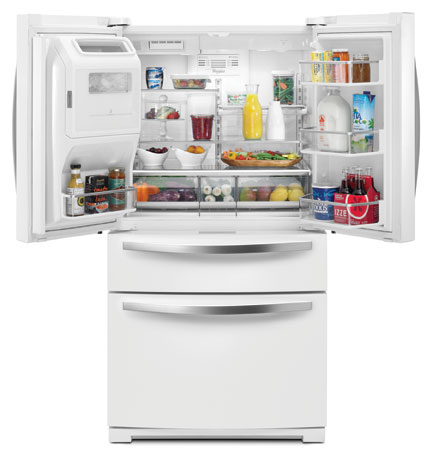Life-Cycle Assessments for Appliances
Full life-cycle analysis reveals transparency in environmental impacts
![]() Continuing Education
Continuing Education
Use the following learning objectives to focus your study while reading this month’s Continuing Education article.
Learning Objectives - After reading this article, you will be able to:
- Identify and differentiate emerging practices involved in quantifying the total environmental impacts of building materials and products.
- Investigate the life-cycle assessment (LCA ) and environmental product declaration (EPD) processes and their relevance to green building design.
- Explore the use of LCA s and EPDs as part of a decision-making process for selecting products to meet green building certifications.
- Demonstrate the ways that appliances can contribute to positive life-cycle analyses and national green programs.
The standards for good green building design and construction are beginning to recognize the total environmental impact of products and materials specified and used in buildings. As commonly defined, an environmental impact related to building products is any change to the environment, whether adverse or beneficial, wholly or partially resulting from an organization's activities, products, or services. These impacts start as soon as raw materials are acquired and then incorporated during manufacturing to create a building product.
In the case of residential appliances, the biggest environmental impacts may occur when a product is being used in a residence. Specifically, energy and water are consumed when using the appliances, which deplete water and fossil fuel sources and contribute to the carbon footprint of the user. The disposal of products at the end of their service life likewise contributes to environmental impacts through the use of energy to transport them from the location of use and relocate them, plus the impact of disposal in landfills, incineration, or other methods. Because of these recognized impacts over the full life of products and materials, there has been increasing interest in finding a reliable method for quantifying, comparing, and documenting the comprehensive environmental impacts related to specific building products. The process and methodologies to analyze the environmental impacts at each stage of the product's life cycle is based on a standardized life-cycle assessment (LCA) process. The development of standardized LCA methodologies has led to the standardization of reporting their results. As such, these reports are quickly becoming the standard for identifying and communicating the total environmental impact of products, including appliances in buildings.
Life-Cycle Assessment Overview
A life-cycle assessment (LCA) is an analysis of every component and phase of a product's life—from the selection of raw materials to the end of its useful service life. The recognized international definition is the “consecutive and interlinked stages of a product system, from raw material acquisition or generation of natural resources to the final disposal.” The life cycle begins with the so-called “cradle” of the product—the extraction or acquisition of raw materials and the transportation of the materials to the manufacturing site. Next, the manufacturing phase occurs where labor, equipment, and energy are used to transform the raw materials into the building material or product. Once completed, it is deemed to be at the “gate” and ready for shipping. The finished products then move into the construction phase by being transported to the jobsite and incorporated into the building construction.

Image courtesy of Whirlpool Corporation
The use of life-cycle assessments is leading to improvements and advancements in the design of residential appliances to reduce environmental impacts.
After installation of the products when the building is placed into service, the products live out their use phase, using fossil fuels and water to perform their functions in the case of household appliances. Finally, at the end of the useful service life of either the building or the product, then the end-of-life (so-called “grave”) phase emerges where decisions about disposing, recycling, or re-using are made. Some LCAs are more focused and are developed with a specific goal and purpose. Some examples include a cradle-to-gate analysis, which is concerned about the things that a manufacturer has direct control over. Other examples include an economic input-output analysis, social LCAs, and comparative LCAs. Overall, the idea behind any LCA is to analyze the selected product holistically, as opposed to looking at only parts of the product and their environmental impacts.
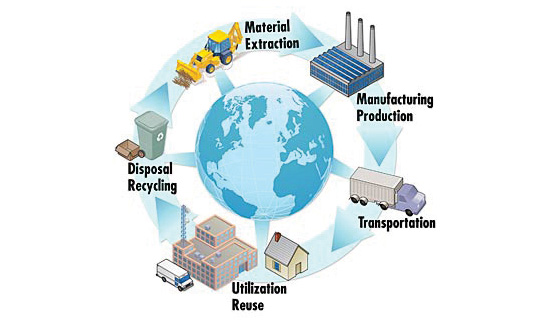
Image courtesy of Whirlpool Corporation
A life-cycle assessment (LCA) takes into account all aspects of a product, beginning with raw materials all through to the end of its service life.
Previously, the evaluation of environmental impacts over the life of a product relied purely upon manufacturer claims. Now, however, independently conducted life-cycle assessments based on established standards have emerged as important tools for comparing environmental attributes between similar products. This has come about through the development of several fundamental standards and guidelines, which are basic to an understanding of the LCA process including the following:
International Standards
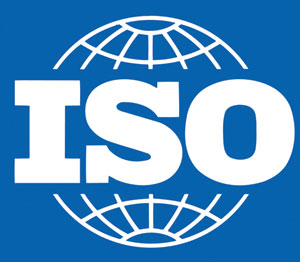
Image courtesy of Whirlpool Corporation
The International Organization for Standardization (ISO) has developed very detailed protocols for a life-cycle assessment and environmental product declarations.
The International Organization for Standardization (ISO) (www.iso.org) has become recognized around the world for establishing standards for a variety of different industries and methodologies including the development of LCA standards and rules. Since the founding of the ISO in 1947, they have published more than 19,500 International Standards covering almost all aspects of technology and business. This organization, while an independent body, is actually a network of national standards organizations from many countries. In the U.S., the American National Standards Institute (ANSI) is the member body that participates in and contributes to the standards that are promulgated under ISO. A process of global consensus is employed for these voluntary standards with the intentions of creating industry standard specifications for products and services, helping to make industries more efficient and effective, helping to promote consistency between different regions, and breaking down barriers to international trade.
The published standards in the ISO 14000 series address a broad range of environmental management. Specifically, the document ISO 14044 details the requirements and guidelines for conducting an LCA. Other related ISO standards and publications address LCA principles and framework (ISO 14040), data documentation format (ISO/TS 14048), and illustrative examples (ISO/TR 14047, 14049). They are all based on the premise that “a compliant LCA addresses the environmental aspects and potential environmental impacts (e.g. use of resources and the environmental consequences of releases) throughout a product's life cycle from raw material acquisition through production, use, end-of-life treatment, recycling, and final disposal (i.e. cradle-to-grave).” They also go on to identify four phases in a standardized LCA study:
a) the goal and scope definition phase including identification of those things to be specifically included
b) the inventory analysis phase also called a life-cycle inventory (LCI)
c) the impact assessment phase looking at the actual or calculated impacts
d) the interpretation phase pulling it all together.
Altogether, these documents provide the ISO requirements and provide detailed guidelines for conducting an objective life-cycle assessment. In much the same way that building products are tested by independent laboratories for any range of other characteristics, an ISO-compliant LCA can be conducted by an independent third party following the requirements of the standard, thus ensuring that accepted methodologies were used to perform the LCA and that the results should be consistent with LCAs that follow the same methodologies.
Impact Categories
In an ISO-compliant LCA, environmental impacts are broken out and organized into different specific impact categories to describe the effects during a product's life cycle (or individual phases) on specific areas of concern. These impact categories include things like fossil fuel depletion (embodied energy), global warming (carbon footprint), water depletion, metal depletion, and various air pollution impacts. The ISO standard requires that specific environmental impact categories must be measured and included in the LCA and subsequently reported on. Other categories can be added beyond these basic minimums. (See sidebar “Common Impact Categories for Appliances” on the previous page.)
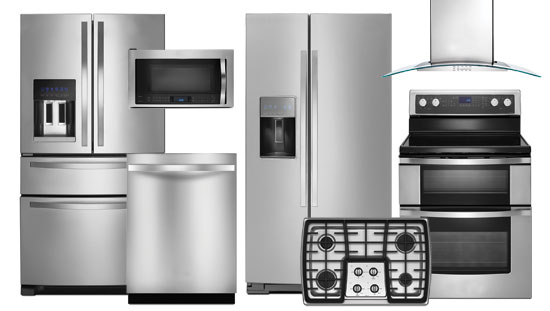
Images courtesy of Whirlpool Corporation
The use of LCA allows appliance manufacturers to assess their existing line of appliances and determine where to make improvements that reduce environmental impacts.
Product Category Rules (PCR)
A product category rule (PCR) is relevant only to a specific type of product or material meaning it is written for all products/materials within its category (i.e. roofing or flooring or appliances, etc.). With a PCR in place, the method for conducting and reporting the results of an LCA in an EPD is standardized for products within the category. This ensures that all products in a certain product category, regardless of manufacturer, are measured the same way in each life-cycle phase. The PCR defines the specific impact categories that must be addressed and determines the common functional units of measurement (e.g. square feet, BTUs, tons, etc.) so direct comparisons can be made between individual products. To be in compliance with the ISO standards, all impacted stakeholders must have an opportunity to participate in the development of the PCRs. At present, there is not a large number of PCRs since they can be expensive and time consuming to develop. However, this is starting to change, and more PCRs are being developed each year for different categories of building materials and products including some for specific appliances.
Environmental Product Declaration (EPD)
The ISO acknowledges an Environmental Label as a “claim which indicates the environmental aspects of a product or service.” It goes on to clarify that an environmental label or declaration may take the form of a statement, symbol, or graphic on a product or package label, in product literature, in technical bulletins, in advertising, or in publicity, among other things. In practice, EPDs are published by the product manufacturers, usually as a summary document for each product or class of products they are making a declaration about.
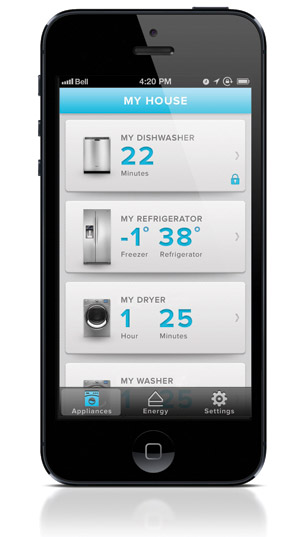
Image courtesy of Whirlpool Corporation
To help consumers optimize the energy their appliances use, some appliances have smart phone apps that control the duration and the time that appliances run.
Once the LCA for a product or class of products is completed following ISO 14044, other ISO documents take over for the EPD preparation. There are standards for three types of EPDs: Type I prepared by independent third parties; Type II, which are self-proclaimed; and Type III prepared by a program operator. A program operator can be a company or a group of companies, industrial sector or trade association, public authorities or agencies, or an independent scientific body or other organization. In most cases it is a Type III EPD that is prepared, hence ISO 14025 is the primary standard used since it establishes the principles and specifies the procedures for developing both the specific programs and the actual declaration documents for Type III environmental declarations. Type III environmental declarations are primarily intended for use in business-to-business communication, but their use in business-to-consumer communication under certain conditions is not precluded. The document specifically establishes the use of the ISO 14040 series of standards related to LCA as the basis for Type III environmental declarations. The series also references other ISO standards including ISO 14020, which defines general principles of all EPDs of all types.
When completed, a standardized EPD is the ultimate outcome of an ISO 14044-compliant life-cycle assessment for a particular product following the appropriate PCRs. In essence, it summarizes all of the basic materials and processes required over the life cycle of that product, from raw material extraction, through manufacturing, transport, use, and end of service life recycling or disposal.
An EPD presents the summary of the quantified environmental data for products or systems. EPDs are voluntarily developed by manufacturers or trade associations, but since they are typically verified, at least in part, by independent third parties, their purpose is to provide reliable and comparable information regarding the environmental performance of similar products in a product category. EPDs enable architects, building owners, and other members of the design team to make direct comparisons of the environmental attributes—such as carbon footprint and embodied energy—of similar products. Hence, products can be assessed when they may have the same traditional attributes (e.g. performance, cost) but need to be selected and specified based on minimizing negative environmental impacts. EPDs are used often for comparison of two (or more) products to determine where the differences lie in the product or the process of its life cycle.
When it comes to reporting impact categories in the EPDs, ISO 14025 requires eight categories at a minimum with the PCRs defining additional impact categories, if any, that must be included. Of course, EPDs can always report more impact categories than required by the PCR. Architects should consider which impact categories are of greatest interest for their projects. For instance, while carbon footprint is likely always a concern, in the arid Southwest, impact on water resources might be of particular concern.
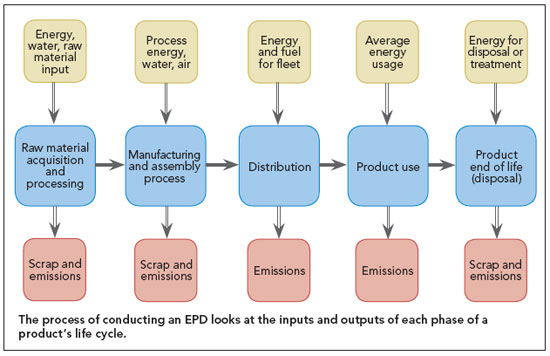
Image courtesy of Whirlpool Corporation
All across the United States, there has been increased interest in EPDs with some of the attention being driven by federal agencies, such as the General Services Administration (GSA), to potentially use EPDs as a vehicle to comply with Executive Order 13514 requiring government agencies to purchase environmentally preferable products. The U.S. Green Building Council (USGBC) has also incorporated EPDs as a part of the LEED version 4 green building rating system in the Materials and Resources (MR) section, which has been substantially revised. Points that were previously available for regional materials and recycled content are being rolled into the points available for LCAs and EPDs. Happily, the USGBC is not asking project design teams to conduct LCAs or to become product and material experts. Instead, the project team will be able to request an EPD (or perhaps another approved form of reporting) that discloses the required LCA-based information. In essence, LEED version 4 will ask product manufacturers to gather the life-cycle information on their products and to disclose relevant portions of that information in the standard EPD format. The new relevant credits are anticipated to affect four out of the five MR credits beyond the prerequisites and earn up to 11 points in the process.
Clearly, EPDs are seen as an important validation tool that allows manufacturers to objectively assess the environmental sustainability of their products, while providing buyers with clear and credible information necessary to make product comparisons. In addition, buyers and product specifiers are increasingly demanding transparent data that supports claims of the environmental sustainability of the products they select, ensuring a growing demand for EPD-backed products. In the increasingly competitive marketplace for environmentally sustainable solutions, EPD-backed products better enable specifiers and buyers to make objective and informed purchasing decisions. Finally, manufacturers who use EPDs help to create a greater public awareness of the environmental impact aspects of products, thereby contributing to global sustainability efforts.
When it comes to appliances, the LCAs and EPDs are currently most widely done to assess existing products. While using LCAs for comparison purposes are useful, the real reason manufacturers complete them is to make improvements in their products. Typically, the results are used internally to quantify the environmental impacts of the products and help to guide product development or materials decisions. LCA results can also be used to assess the environmental footprint of a product over time and to support marketing claims for products. It is important to remember that LCA is a complex modeling tool that has to rely on the best possible data available to provide a good estimate of impacts. Nonetheless, becoming aware of where the biggest environmental impacts in a product's life cycle exist gives manufacturers clear direction for making important changes to reduce those impacts.
Appliance Industry Sustainability Standards
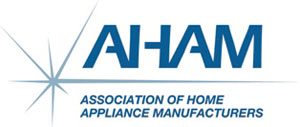
Image courtesy of Whirlpool Corporation
The Association of Home Appliance Manufacturers is developing sustainability standards based on identifying “hot spots” in the life cycle of appliances.
The appliance industry trade association is the Association of Home Appliance Manufacturers (AHAM) representing manufacturers of major, portable and floor care home appliances, and their suppliers throughout the U.S. and Canada. Altogether, AHAM boasts a membership of over 150 companies located throughout the world. In addition, AHAM is also a standards development organization, accredited by the American National Standards Institute (ANSI). In that role, it has authored numerous appliance performance testing standards used by manufacturers, consumer organizations and governmental bodies to rate and compare the performance and quality of appliances.
AHAM is in the process of developing Sustainability Standards for all mainstream appliances, small and large, with the very active participation of manufacturers. These standards are being created based on a standard LCA process but with an added focus on “hot spot” analysis. This means that the AHAM standard allows for points to be earned that are allocated directly proportional to the impact the product creates at the particular stage of its life. As such, these standards create a common metric across the industry to help consumers compare the sustainability of appliances. To date, AHAM has released two appliance standards, one for refrigerators and one for clothes washers, and manufacturers have begun using them to certify their appliances accordingly. Standards for dishwashers and cooking appliances are in development as well. The hope is that this will lead to some standardized labeling for appliances so that specifiers and consumers will be able to minimize the number of labels needed to understand the overall environmental impact of a particular appliance.
Refrigerators
The Sustainability Standard for Household Refrigeration Appliances was first published in June of 2012 and was produced as a joint effort between AHAM, Canadian Standards Association (operating as CSA Group), and Underwriters Laboratories (UL). Because of this tri-party development and publication, the standard is cited as AHAM 7001-2012/ CSA SPE-7001.12/ UL 7001. It recognizes that the environmental performance of refrigeration home appliances has commonly been evaluated on the single environmental attribute of electricity consumption during use. This Standard was intentionally developed using life-cycle thinking with a broader, multi-attribute, and more holistic approach to assess the environmental impacts of refrigeration home appliances using life-cycle assessment (LCA) data along with other key factors. Eligible refrigeration products can be evaluated for their sustainability under this standard based on six attributes each of which provides points that can be awarded through a combination of prerequisite and optional point items as follows:
(a.) Materials – 25 points
(b.) Energy consumption during use – 45 points
(c.) Manufacturing and operations – 15 points
(d.) Product performance – 5 points
(e.) End of life – 10 points
(f.) Innovation (bonus attribute) – 10 points
TOTAL points available – 110 points
Note: The first five attributes are required; Item (f), innovation, is a bonus attribute, and is therefore not required.
For refrigeration appliances to be considered as having some level of recognized environmental performance under this Standard, such appliances shall:
(a.) Receive a minimum total of 60 points
(b.) Meet ENERGY STAR® performance criteria within the attribute of “energy consumption during use”
(c.) Meet the requirements of the product performance attribute
(d.) Show a balanced manner of reaching the 60 point level such that some points are attained in each of the 5 required attributes (i.e. items (a.) – (e.) above)
Full details of all aspects of the definitions, prerequisites, requirements, and testing of household refrigeration appliances is included in the full publication of the standard.
Clothes Washers
The Sustainability Standard for Household Clothes Washing Appliances was developed in a manner similar to the refrigeration standard development. It was also a joint effort of AHAM, CSA, and UL and is referred to as AHAM-7003-2013/ CSA SPE-7003/ UL 7003. First published in May of 2013, it recognizes that there is more to a sustainable clothes washing appliance than just water use and energy consumption. Eligible products can be evaluated for their sustainability attributes under this Standard based on six categories each of which provides points that can be awarded through a combination of prerequisite and optional point items as follows:
(a.) Materials – 20 points
(b.) Energy and water consumption during use – 45 points
(c.) Manufacturing and operations – 20 points
(d.) Consumables – 5 points
(e.) End of life – 10 points
(f.) Innovation (bonus attribute) – 10 points
TOTAL points available – 110 points
Note: The first five attributes are required; Item (f), innovation, is a bonus attribute, and is therefore not required.
For clothes washing appliances to be considered as having some level of recognized environmental performance under this Standard, such appliances shall
(a.) Receive a minimum total of 60 points
(b.) Meet ENERGY STAR® performance criteria within the attribute of “energy and water consumption during use”
(c.) Meet the requirements of the product performance prerequisite
(d.) Show a balanced manner of reaching the 60 point level such that some points are attained in each of the 5 required attributes (i.e. items (a.) – (e.) above)
(e.) Under the Materials attribute, meet the prerequisite and receive at least one point in certain evaluation subsections
(f.) Under the Manufacturing and operations attribute, meet the prerequisite and receive at least one point in certain evaluation subsections
(g.) Under the End of life attribute, meet the prerequisite and receive at least one point in certain evaluation subsections
The published clothes washing standard goes on to provide the details of all of the attributes, testing and documentation required similar to the refrigeration standard. It is anticipated that AHAM will continue to develop similar voluntary standards for other types of appliances. In fact, they have pending standards for dishwashers and cooking appliances that may be released during 2014.
Addressing Appliance Life-Cycle Impacts
Using the ISO and AHAM standards as a guide, manufacturers have been learning a great deal about the environmental impacts of their appliances. Those that have engaged in the EPD process have looked at the specific impact categories required and have been able to determine where in the life-cycle process those impacts occur. In particular, refrigerators have been recognized by the US Environmental Protection Agency (EPA) and others as the most energy consuming appliance in a home which is logical given that it is the most complex to create and needs to operate continuously during its use phase. Manufacturers who have performed LCAs and EPDs on household refrigerators, therefore, have been making strides to reduce the negative impacts while building on the positive ones. Some of those efforts are summarized in the following discussion.
Appliance Raw Material Acquisition and Processing
This “cradle” portion of an appliance includes energy, water and material inputs required to bring raw materials and pre-made parts to the manufacturing plant. To the extent that re-cycled steel can be used in appliances, it is being pursued and scrap material is often reclaimed for this purpose. The other required materials are commonly purchased plastic fabrications or pre-made hardware such as screws that are shipped as finished pieces to the manufacturing plant. Those pieces have varying degrees of environmental impact depending on the particular material, the fabrication processes used, and the distances that they are shipped. One proactive initiative is the use of returnable packaging and pallets required for shipping the various parts. This initiative minimizes the impact of those shipping materials allowing them to be used repeatedly until they need to be ultimately recycled and made into something else.
Manufacturing and Assembly
Once all of the materials and parts are at the manufacturing plant, energy and other resources are required for manufacturing certain parts from raw materials and assembling the bought pieces into different subsystems ultimately creating the finished overall product. All of the associated scrap, emerge and emissions, and packaging are accounted for in this manufacturing and assembly process. Scrap can be collected while recycled, energy use and emissions can be minimized based on operations and fuel types. This includes the impact of specific processes such as painting the steel housing of the refrigerator which can be likened to an automotive painting process. The biggest distinction is that appliances often only require 1 to 2 coats of paint over a pre-treatment coating while automotive painting often requires 5 to 7 coats. Conservatively speaking, then, the appliance painting process has 50 to 70 percent of the impacts of automotive painting.
Refrigeration appliances also require insulation to be incorporated into the enclosure of the appliance to help it maintain the temperature when it is operating. Typically, manufacturers use a spray foam insulation that requires blowing agents to deliver the insulation into the cavity of the refrigerator or freezer. Materials used as blowing agents are rated based on their Global Warming Potential (GWP) compared to carbon dioxide (CO2), the most basic greenhouse gas with a GWP rating of 1, the lowest on the index. By comparison, compounds such as nitrous oxide have a 20 year GWP of over 200 while hydrofluorocarbons can have 20 year GWP ratings anywhere between 3,400 and 12,000 depending on its makeup. Obviously, using a blowing agent that has a low GWP rating is a much more environmentally sensitive choice.
With the GWP issue in mind, and in the interest of manufacturing more environmentally responsible refrigerators and freezers, some appliance manufacturers have started changing the blowing agents used in the spray foam insulation. By switching from blowing agents with high GWP ratings to alternatives with lower GWP, they can reduce their impacts down to a rating of 1. This makes it the lowest possible, the same as carbon dioxide, and is non-ozone-depleting. The difference can be dramatic when compared to other common blowing agents, so much so that when one manufacturer makes the switch it could have an impact on global warming the equivalent of removing more than 400,000 cars from the road.
The final step of manufacturing and assembly is the packaging and preparation for shipping which bring us to the “gate” in the life-cycle of an appliance. Once again, the use of packaging that can minimize waste and encourage recycling of packaging material is worth undertaking by manufacturers. From there the most effective and least polluting means of shipping and transportation needs to be identified to deliver the products to the building where they will be ultimately used.
Usage Phase
No matter which major appliance is being discussed, the greatest environmental impact of the appliance by far comes from the use phase of the appliance. In fact about 80 to 90 percent of all environmental impacts of appliances are attributable to the energy (with corresponding emissions) and water consumed during the product's usage phase. Therefore by focusing heavily on energy and water efficiency improvements in appliances, manufacturers have been making significant strides in reducing the impact of appliances.
Energy usage reduction has come about through continued improvements in the operating technology of appliances since the 1980s when federal legislation was first passed requiring minimum performance standards in appliances, among other things. Since then, the minimum performance threshold has been steadily raised and the ENERGY STAR® program has recognized those appliances that exceed those standards by a defined percentage. The AHAM sustainability program also awards the most points in the energy efficiency category and requires ENERGY STAR® labeling first before an AHAM distinction is earned. Clearly there are plenty of external reasons encouraging energy use reduction while an EPD will reveal just how effective those efforts are in a given line of appliances.
Water usage has been a similarly strong focus for appliances like dishwashers and clothes washers that need water to operate. LCA studies have found, for example, that many dishwashers have become so efficient in their use of water that it is now much more favorable to the environment to wash dishes using a dishwasher compared to hand washing. By reducing the water consumption overall, water as a resource is depleted less and the environmental impact of processing and treating that water is less.
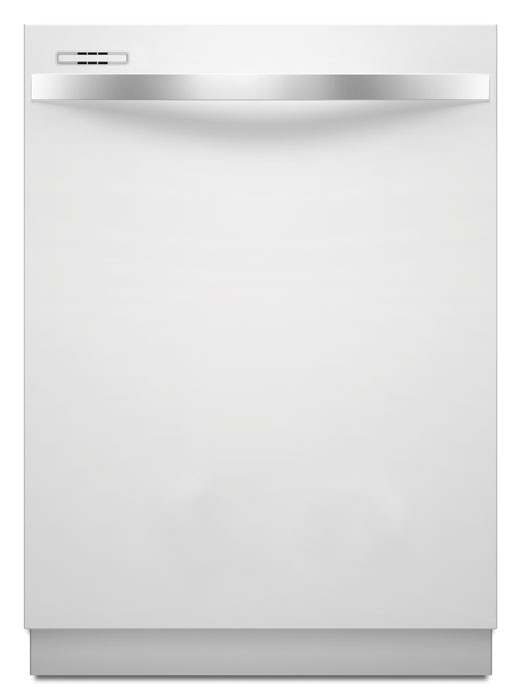
Image courtesy of Whirlpool Corporation
Water consuming appliances like dishwashers have increased in efficiency to the point where they use less water than washing dishes by hand.
A growing trend in appliances is the use of electronics to gain better control of how and when they operate. In some locations, rates for electricity vary by time of day or night based on peak and non-peak hours. Hence, it is becoming common to see smart phone apps that can be used to program when appliances run or operate them remotely to take advantage of off peak economic savings. In locations where there is a computerized “smart grid,” then “smart appliances” can tie in and read directly when the off–peak hours are and operate accordingly. By using and programing appliances in this way, economic, social and environmental impacts can be minimized either directly or indirectly.
End of Service Life
Appliances can be expected to last a decade or more, but as they wear out or become obsolete compared new energy and water use improvements, they all eventually need to be replaced. Given their size and the durability of the materials, sending them to landfills is no longer an acceptable option in most cases. Rather, manufacturers have been initiating take back programs as an initiative to recycle the materials and the parts of the appliance more completely. They recognize that up to 90 percent (based on weight) of the materials used in an appliance are fully recyclable, and are actually of high value, which makes recycling them profitable. Implementing a program like this helps reduce the end-of-life impacts to the point where it becomes a positive impact offsetting other negative ones in an EPD.
Conclusion
When looking at the environmental impact of buildings and the things that go into them, life-cycle assessment and environmental product declarations are becoming key tools in identifying and comparing appropriate product choices. National and international standards have been developed to create a uniform process for gathering and reporting information with varying degrees of third party verification available. Appliance manufacturers have begun to embrace this process as a means to improve their own product line but also to distinguish themselves from others. When considering and selecting appliances, the use of these emerging tools allows architects and designers to choose the most environmentally friendly appliances across their full life cycle.
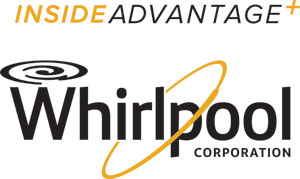 |
Whirlpool Corporation, the leading manufacturer of major home appliances, brings you Inside Advantage—innovative products providing efficiency and performance; market insights helping you to create more appealing designs; and targeted services that make doing business with them easier and more profitable. |

